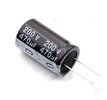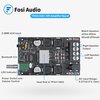Ok
audioguru, time for your expertise once again. Right now in my speakers i am using 2 "wuzhi" 2x50W amplifiers. First one costs about 5$ and has a no name chip, second one costs about 7$ and has TPA3116D2 on it. I am super super super happy with both amplifiers. I am using the later one right now as my main amp for my room stereo system. Before it, i had a pioneer amp, a furnace, that cost prolly around 150-200$ when it was new. And i swear to god i cannot hear the difference between the big pioneer amp and this tiny 7$ TPA3116D2. It was meant as a temporary solution until i buy a new amp but right now, i simply have no motivation.
Even though both "WUZHI" amps are rated at 2x50W, i feel that the 7$ one is a bit louder (at least my friends say so) and it packs more bass. At 100% volume the woofer membrane moves more and you can hear more bass. I also belive that there is less distortion at 100% volume than with 5$ amp, again, i am talking about what me and friends can hear, not about graphs. So in my opinion it is worth the extra 2$.
But now my question and i cant even belive i am asking you this, 2 years ago it was a fantasy. With this speaker i would gladly lose 3dB of bass and get 3dB more overall loudness. Meaning it will have a tiny bit less bass and tiny bit more loudness. Barely noticable but still, it would be a good tradeoff for me. Now an easy solution would be just to change the length of bass port to go less low but give it a slight boost at around 80-120Hz. But that will again increase the bass effect (boomy thingy u called it) and whats worse, it will completely mess up with my schematics. I made excel sheets where i have all the data and it calculates the exact dimensions of wooden parts and port. And as it is, the stupid port is taking a huge chunk of my speaker. So i am wondering is there any other simple solution to do this ? Without changing the amp and investing huge amounts of money since im on a budget. Looking for a new woofer also isnt a solution. This dayton is the only thing in its price range to be useful, i mean if i am to belive the data, its far ahead of everything else u get for 14$. And if i cant belive the data its all for nothing anyway since i dont have a studio equipment.
And a sub question. Right now i use 3L wooden box for the speaker. But it would be nice to make 1 for me thats like 4 or 5L, a special speaker just for me. How the hell am i going to find a speaker for that ? The one i am using kinda peaks out at 2L meaning when u go over 2L, you barely see a change in the graph. But when i went through all possible bigger speakers (dayton is 4", i went checking 4.5" and 5"), they all needed a LOADs bigger box than 3L. So i am either stuck with this one at 3L or i need a 8L box for an 4.5" or 5". And 8L is like my backpack.




